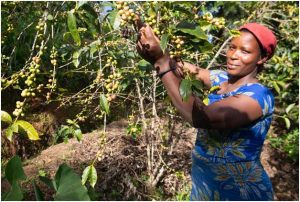How can Taps, Toilets & Good Hygiene Help Ensure Sustainable & Resilient Agricultural Supply Chains?
 13 November 2019
13 November 2019

Credit: WaterAid/ James Kiyimba
By Ruth Romer
LONDON, Nov 12 2019 (IPS)
Water underpins the global economy and agriculture is by far the world’s largest water consumer, accounting for 70% of freshwater withdrawals. Global water demands are projected to increase by 55% by 2050 and climate change will present further pressures on water accessibility.
Many agricultural supply chains, from the smallholder to large commercial farms, originate in countries where large proportions of the population have no access to safely managed water and sanitation services, such as in sub-Saharan Africa and South Asia, and this presents various social and environmental challenges.
Companies reliant upon the agricultural supply chain have a significant role to play in the management of water, sanitation and hygiene (WASH) as well as a stake in ensuring supply chain security.
A new booklet ‘Water, Sanitation and Hygiene: Three Essential Ingredients to Resilient Agricultural Supply Chains’ launches this week at the annual Alliance for Water Stewardship forum.
Co-authored by Alliance for Water Stewardship, Diageo, UN CEO Water Mandate, WaterAid and WASH4Work, it highlights why and how companies that rely on agricultural supply chains should invest in WASH management.
Having reliable access to these basic services would not only improve the health and welfare of the workers; it can support a resilient business whilst helping mitigate against the impacts of climate change.
Why do companies with an agricultural supply chain need to invest in WASH?
Access to adequate WASH services remains critical at every stage in agricultural supply chains. The following physical, financial, reputational and regulatory risks and opportunities need to be managed within an environmental and social lens to ensure long-term economic benefits:
- • Physical – Projections show that more than 40% of people will live in areas of severe water stress by 2050. Together with declining water quality issues, this will exacerbate the challenges of water availability for households and crops. The lack of decent sanitation for agricultural workers can also have a detrimental effect on the quality of local water resources.
• Financial – At the macro-economic scale, it is estimated that every US $1 invested in WASH generates US$ 4.30 through increased productivity. In collaboration with partners, WaterAid is driving more work on the micro-economic business return on investment.
• Reputation – Responsible water management and adequate access to WASH for workers and surrounding communities not only benefits the health and dignity of staff and farmers, but also stakeholder relations. Companies with a good reputation can reap business benefits.
• Regulation and compliance –The United Nations mandates clean water and decent sanitation as a basic human right – and it is a state’s obligation and a company’s responsibility to respect human rights. Internal corporate policy or HR policy, which incorporates WASH elements or global targets, can also help drive internal compliance and alignment with business as usual practices.
How can companies prioritise WASH?
For many companies, the environmentally focused elements associated with access to water to produce the raw material, as well as water-use efficiency and discharge in processing, are often prioritised over the social elements.
However, WASH can be a risk to social license to operate and production capabilities, so water security for business operations requires a more holistic approach.
WASH management should integrate considerations of not only the workers, but also the broader supply chain and the communities in which the workers live.
Once fully embedded within a company’s corporate water stewardship plan with clear corporate policy commitments or targets, the local level implementation can be easier, especially if there is top-down endorsement.
The Alliance for Water Stewardship Standard provides a useful framework for a company to consider WASH management issues at site-level.
The booklet does not intend to provide detailed site-level guidance; however, it provides a primer to build the case for action. It
highlights, alongside associated guidance, the following recommended steps:
- • Champion the integration of WASH into the company’s corporate water stewardship strategy.
• Assess WASH needs at the local level to understand the shared potential water challenges, risks, impacts and opportunities.
• Develop a local level WASH stewardship plan including targets.
• Engage with a third-party provider to support practical action and implementation if in-house resources do not exist.
• Engage with global initiatives to learn from the experience of others.
One in ten people lack clean water while one in four have no decent toilet. While many companies have provided access to these basic services at their workplaces, the real opportunity lies across supply chains, particularly agricultural ones.
Only then can business truly support universal access to WASH as well as working towards sustainable and resilient supply chains.
Find out more at https://washmatters.wateraid.org/publications/water-sanitation-hygiene-resilient-agriculture-supply-chains.
The post How can Taps, Toilets & Good Hygiene Help Ensure Sustainable & Resilient Agricultural Supply Chains? appeared first on Inter Press Service.
Excerpt:
Ruth Romer is Private Sector Advisor, WaterAid
The post How can Taps, Toilets & Good Hygiene Help Ensure Sustainable & Resilient Agricultural Supply Chains? appeared first on Inter Press Service.
